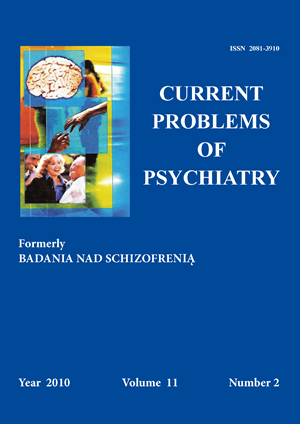Psychometric propertiesof the Disturbed Family Relationships Questionnaire (KBZRR)
Keywords:
disturbed family relationships, questionnaireAbstract
The article presents the stages of developing the Disturbed Family Relationships Questionnaire (Kwestionariusz do Badania Zaburzonych Relacji w Rodzinie, KBZRR). In the first stage, a questionnaire was developed, which consisted of 60 questions describing different aspects of disturbed relationships between parents and children. 185 women, aged 16-19 years, were assessed using this version of the questionnaire. After that, the items were reviewed, and the questions with weak variation were withdrawn. As a next stage, a factor analysis was performed, which allowed to elicit 5 factors: (1) Violence, (2) Overprotectiveness, (3) Coalition with the mother, (4) Lack of acceptance –Rejection, and (5) Indifference. Items with the lowest factor loadings and with the lowest indicators of factor specificity were withdrawn. The final version of the questionnaire consisted of 36 questions. Cronbach coefficient alpha reliabilities for each factor were high, as follows: 0,87 for Violence, 0,79 for Overprotectiveness, 0,83 for Coalition with the mother, 0,71 for Lack of acceptance – Rejection, and 0,79 for Indifference. The selected factors together explained 48% of variance using 36 items.
References
1. Pawłowska B., Zaburzenia odżywiania u kobiet w kontekście zmiennych psychologicznych i społecznych, Lublin, Uniwersytet Medyczny w Lublinie, 2007. Rozprawa habilitacyjna.
2. Wójcicka A., Stodulska-Blaszke A. Przemoc domowa – różne definicje , różne reakcje - przegląd piśmiennictwa. Curr. Probl. Psychiatry, 2010; 11(2):
3. Józefik B. Relacje rodzinne w anoreksji i bulimii psychicznej. Kraków; Wydawnictwo Uniwersytetu Jagiellońskiego: 2006.
4. Minuchin S., Baker L., Rosman B.L., Liebman R., Milman L., Todd T.C. (1975): A conceptual model of psychosomatic illness in children. Family organization and family therapy. Arch. Gen. Psychiatry, 1975; 32(8): 1031-1038.
5. Minuchin S., Rosman B.L., Baker L. Psychosomatic Families. London; Harvard University Press: 1978.
6. Root M.P., Fallon P., Friedrich W. Bulimia: a system approach to treatment. New York-London, Ontario: 1986.
7. Roe A., Siegelman M. A Parent – Child Relations Questionnaire. Child Development, 1963; 34: 355-369.
8. Kog E., Vandereycken W. Family interaction in eating disorder patients and normal controls. I. J. Eating Disorders, 1989; 8(1): 11-23.
9. Kog E., Vandereycken W.1989: The Facts: A Review of Research Data on Eating Disorder Families. W: Vandereycken W., Kog E., Vanderlinden J. (eds): The Family approach to eating disorders. New York; PMA Publishing Corp: 1989, pp. 25-56.
10. Weber G., Stierlin H. Familiendynamik und Familientherapie der Anorexia nervosa - Familie. Meermann R. Hrsg. Anorexia Nervosa. Schattauer, Stuttgart: 1981, 108-115.


